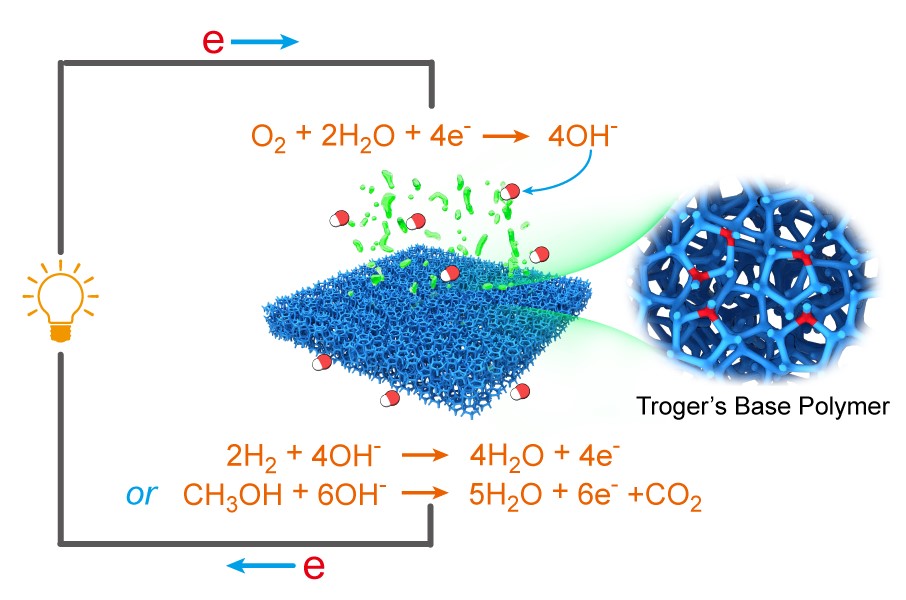Highly Conductive Anion Exchange Membranes from Microporous Tröger’s Base Polymers
Anion exchange membrane (AEM) is an important central component in many electrochemical processes that require selective anion transport and high conduction combined with chemical stability. AEMs are widely used in industrial processes such as electrodialysis, diffusion dialysis, removal or recovery of metal ions from process streams, and electrolysis. Now, current research interest is developing towards chemically stable and highly conductive AEMs for redox flow batteries for energy storage and smart grid, as well as anion exchange membrane fuel cells (AAEMFCs), because the high pH operating conditions reduce costs by allowing non-precious metal catalysts to be used. However, there are considerable materials chemistry challenges for producing anion-selective, highly ion conducting and chemically stable polymer membranes.
State-of-the-art membranes that demonstrate high conductivity of hydroxide anions are typically based on complex polymers designed to self-assemble to provide selective ion transport channels. Here we report for the first time anion exchange membranes derived from microporous polymers, synthesized by the broadly applicable straightforward formation of Tröger’s Base from inexpensive monomers. Prof.Xu and coworkers reported for the first time AEMs with regularly distributed fixed cationic groups, based on the formation of microporous polymers containing the V-shape rigid Tröger’s Base units (Schematically shown in Fig.1). Despite their simple preparation, involving only two synthetic steps from commercially available precursors, the polymers provide AEMs with exceptional hydroxide conductivity at relatively low ion exchange capacity, as well as high swelling resistance and chemical stability. An unprecedented hydroxide conductivity of 164.39 mS/cm is obtained at a relatively low ion exchange capacity of 0.82 mmol/g under optimal operating conditions (Fig.2). The exceptional anion conductivity appears related to the intrinsic microporosity of the charged polymer matrix, which facilitates rapid anion transport.

Fig.1 Highly conductive anion exchange membranes from microporous Tröger’s Base polymers and its potential application in anion exchange membrane fuel cells

Fig.2 Anion conductivity of the Tröger’s Base polymer based anion exchange membranes at varied operating temperature
The reviewer commented that “it is a very interesting piece of work that utilizes commercially-available reagents in order to generate high-performance anion exchange membranes (AEMs). The polymeric materials are well-characterized from a variety of perspectives and the results are impressive. There is a strong possibility that these polymer-based membranes could be of significant interest to the fuel cell community” and this result has been published in Angew. Chem. Int. Ed., (Angew. Chem. Int. Ed., 2016, DOI: 10.1002/anie.201605916).
The first author is Dr. Zhengjin Yang and the co-corresponding authors are Prof. Xu (USTC), Prof. Neil B McKeown (University of Edinburgh) and Prof. Michael D. Guiver (Tianjin University). This work is supported by the Basic Research Program of China (973 project), the National Natural Science Foundation of China, Collaborative Innovation Center of Chemistry for Energy Materials (iChEM), China Postdoctoral Foundation and the Fundamental Research Funds for the Central Universities.
Link: http://onlinelibrary.wiley.com/wol1/doi/10.1002/anie.201605916/abstract
Back
